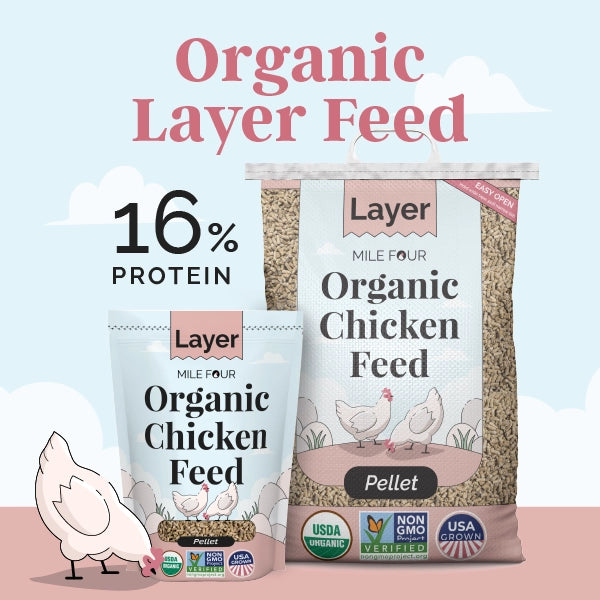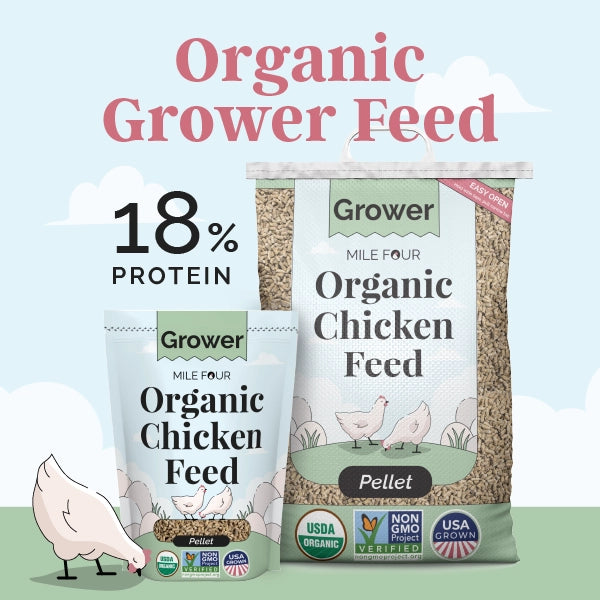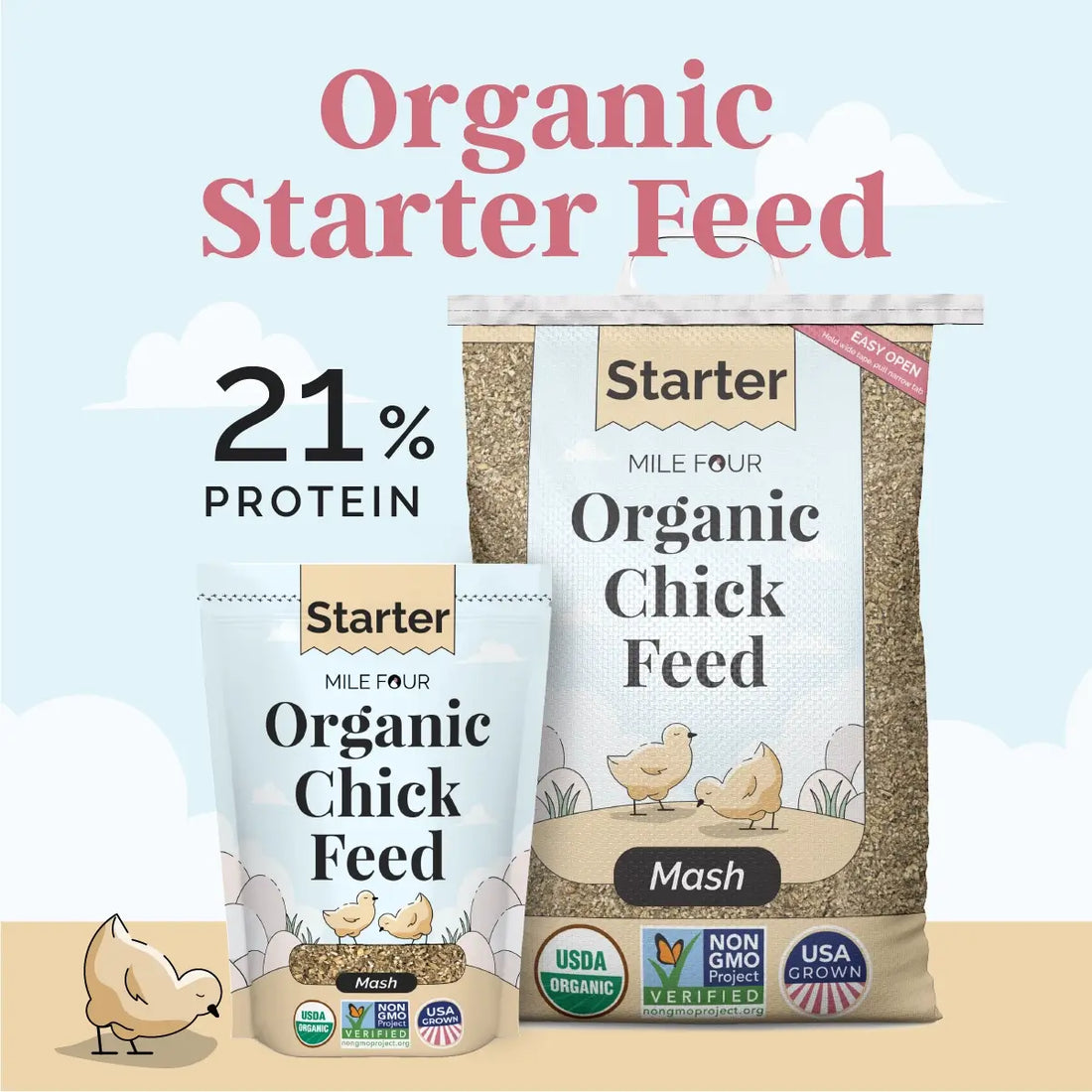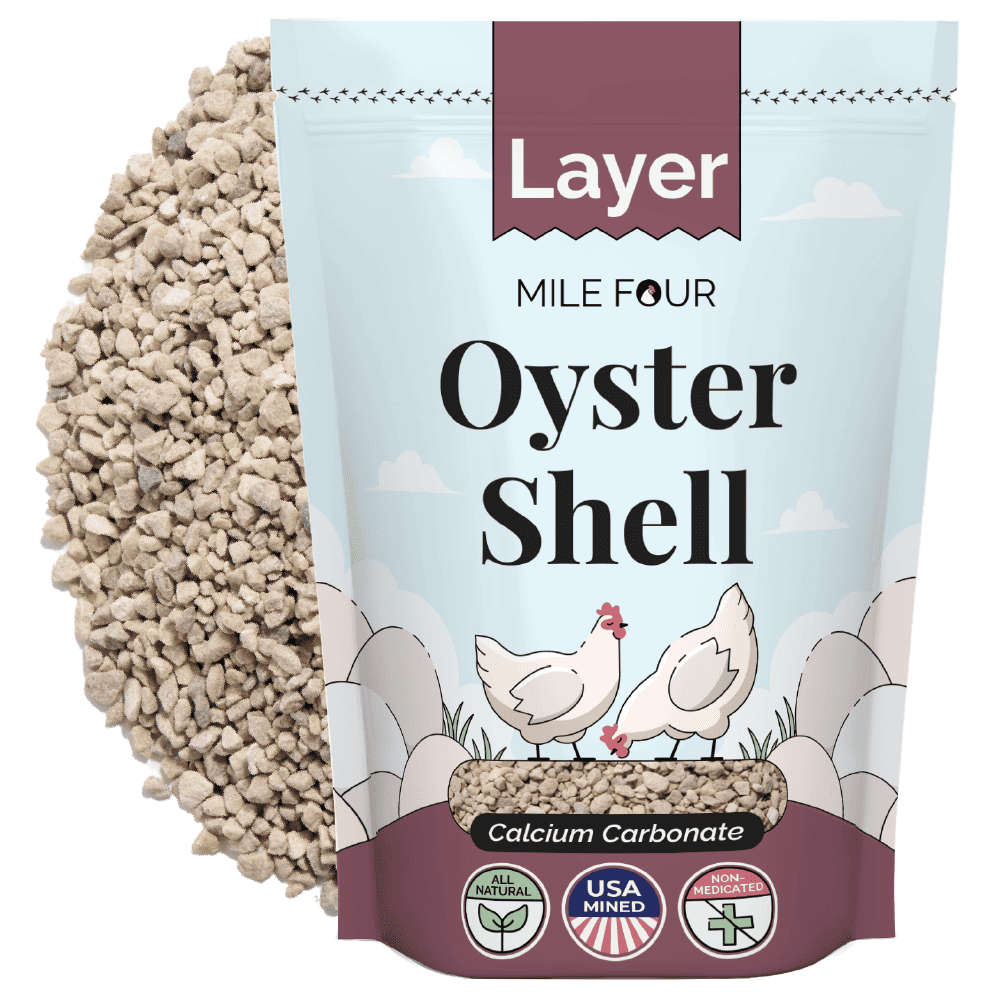Chickens can acclimate to cold climates. They will make it through harsh temperatures as long as you set them up for success.
In this Ultimate Guide, we'll walk you through everything you need to know about winter chicken-keeping, so your flock stays happy and healthy in their coop.
Quick Jump
Chapter 1: Cold-Hardy Chicken Breeds
Chapter 2: Winter Chicken Coop
Chapter 3: Chicken Coop Heaters
Chapter 4: Chicken Frostbite
Chapter 5: What to Feed Chickens in Winter
Chapter 6: Molting Chickens & More
Cold-Hardy Chicken Breeds

Weather Adaptation
Chickens have layers and layers of feathers that trap heat keeping their bodies warm. Most chickens are fully capable of withstanding cold winters that we face year after year.
Most chickens? Why not all? Certain breeds of chickens have larger combs that are most susceptible to frostbite. Some breeds don't have very much feather insulation and are more equipped for warmer climates.
Cold Weather Chickens
If you live in a region that experiences cold winters, you'll want to choose breeds that are cold-hardy. They have smaller combs, larger bodies, and have originated in colder climates, so they are well built for winter.

Find the Right Chicken Breed For You | Take the Test
Best Warm Weather Chicken Breeds
Lightly feathered breeds aren't able to maintain enough heat in their bodies to handle winters well. A few examples of these cold-weather intolerant breeds include:
- Frizzle
- Naked neck
- Leghorn
- Minorca
- Hamburg
Now that you know which breeds are right for your climate, let's talk about gearing up your coop for the cold in Chapter 2.
Winter Chicken Coop

How to Winterize a Chicken Coop
Before winter hits, it's best to take some time to examine the entire coop. Check for cracks, holes, and any damages that need to get fixed before the snow hits.
While it's crucial to make sure there are no drafts in the coop, you also need to have good ventilation, ideally coming from the roof of the coop. Ventilation prevents moisture accumulation, which is not something you want, especially in the winter.
Below are the main components of a winter-proofed chicken coop. We'll dive into each component throughout this guide.

Deep Litter Method
Adding extra bedding to the coop in the wintertime is a great way to help insulate the coop, but replacing that often is timely and expensive.
The deep litter method is a solution to managing your coop bedding in the winter. All you have to do is put down about four inches of bedding and turn it over repeatedly once or twice a week.
Coop Makeover by @the_homegrown_mama
Over time, sanitizing microbes develop in the litter. This process decomposes the chicken poop and eventually turns the whole thing into compost.
The key is to keep turning it over so it can dry out and deteriorate. Make sure there are no areas that are matted down.
Check out all these benefits of the deep litter method!

READ: Chicken Coop Bedding Guide
Completely clean the coop before you start this process. Begin the deep litter in the fall. If it's already winter, it's too late. Carefully monitor the process and never put diatomaceous earth down in the coop when deep littering.
If you want to learn more about the Deep Litter Method and other coop bedding options such as Hemp Bedding, check out our Chicken Bedding Guide!

Check out Mile Four's Hemp Bedding
Winter Chicken Run
Chicken keeping is all fun and games until your entire run is hidden in three feet of snow. Don't let that be the end of playtime in the run! There are many things you can do to make the run accessible and enjoyable for your flock.

What about coop heaters you ask? We'll take a deep dive into that hot topic next.
Chicken Coop Heaters

Do You Need a Chicken Coop Heater?
Heated chicken coops are a hot topic, mostly because of the risks that come with them. Most backyard chicken breeds are naturally equipped to handle cold winters, especially when the coop is well-ventilated, dry, and draft-free. For that reason, most poultry experts advise against using a coop heater.
Despite the warnings, many chicken keepers in regions where temperatures drop below zero still choose to use a heater. Some have had no issues at all; others have unfortunately experienced equipment failures or even lost their coop and flock to a fire.
Before turning to artificial heat, it’s worth focusing on safer, reliable alternatives. Deep bedding, wind protection, proper ventilation, and a dry coop do far more for winter chicken care than a heater ever will. These steps support natural heat retention, reduce moisture (which is a major frostbite risk), and lower overall danger.
We recommend taking these measures first instead of relying on a coop heater.
Dangers of a Chicken Coop Heater
Aside from the risk of a coop fire, another major concern with chicken coop heaters is what happens during a power outage. If your flock becomes acclimated to a warm coop and the heat abruptly shuts off, the sudden temperature crash can shock their system. Chickens handle cold well, but they do not handle rapid temperature swings — and in severe cases, this can be deadly.
If you decide to use a heater, use it very conservatively. Make sure it’s set to keep the coop only slightly warmer than the outside air, not to create a warm indoor environment. This reduces the threat of heater dependency and minimizes the risk of extreme temperature shifts.
It’s also essential to use only coop-rated, enclosed heating units, keep all cords protected from pecking and moisture, and mount the heater in a way that avoids contact with bedding, dust, or feathers — all highly flammable.
Now that you are aware of the risks of a coop heater, the final decision is completely up to you. Your flock, your comfort level, your choice.
In the next chapter, we’ll talk more about frostbite prevention and how to reduce cold-weather risks without relying on heat.
Chicken Frostbite

Preventing Frostbite in Chickens
Frostbite is caused by excess moisture in the cold air, which freezes the fluid in the cells of a chicken's wattles, comb, or toes.
Everything we've talked about thus far is a good way to prevent your chickens from getting frostbite. For a refresher, the most important frostbite prevention measures are listed below.
- Reduce moisture by removing damp litter and improving ventilation
- Eliminate drafts by patching any cracks in the walls or ceiling of the coop
Make sure you are keeping an eye out for signs of frostbite on combs, wattles, and feet of your flock. The photo below shows what frostbite looks like on a chicken's comb.

Treating Frostbite in Chickens
If you spot a chicken with a pale-looking comb or wattle and the tissue is still frozen, your goal is to thaw it gently and safely. Bring the bird into a warm, quiet area and take things slow. Rushing thawing or rubbing the skin can cause deeper damage.
For frozen tissue:
- Apply a warm (not hot) cloth for about 10 minutes.
- Never rub or squeeze the area; let the heat do the work.
- Once thawed, pat dry and apply a thin layer of plain Neosporin.
- Move the chicken to a separate, draft-free space to rest and avoid flock pecking.
- Offer warm water or electrolytes if the bird seems stressed.
Sometimes frostbite is only noticed after the tissue has already thawed on its own. In that case, the comb or wattles will look swollen or puffy. The damage is already done, but you can still help the bird heal comfortably.
For already-thawed frostbite:
- Gently apply daily Neosporin to keep the skin protected.
- Keep the chicken isolated until swelling goes down and the tissue stabilizes.
As the area heals, the frostbitten portion will gradually darken, dry out, and eventually fall off naturally. It won’t grow back, so it’s important to let this process happen on its own. Avoid trimming or picking at the tissue; forced removal can cause bleeding, pain, and infection.
We don’t share this to worry you — only to highlight how important prevention is. With good ventilation, dry bedding, and solid wind protection, frostbite becomes much less likely in the first place.
Now let’s turn to a much more cheerful topic: keeping feed & water flowing through winter!
What to Feed Chickens in the Winter

Feeding Chickens in the Winter
During the winter, chickens use more energy to stay warm in the wintertime. They need to eat more carbs and protein so their bodies are working to create energy, which creates internal heat.
Increasing your chicken's protein level in their feed to 18% will help provide your chickens' with more energy to produce internal heat during cold winter. Higher protein (18% vs 16%) helps birds maintain body condition in cold weather. Protein supports feather regrowth, muscle repair, and overall energy balance.
Carbs are converted into energy faster than protein, which is why scratch is a popular morning or evening snack. Morning time for internal heat until birds are warmed by radiant heat from the sun and evening time to boost body heat while perching through the night.
If you feed your chickens scratch, make sure scratch (or other treats) do not comprise more than 10% of their total diet.
This is also a great time to ensure your flock has free-choice grit and oyster shell available.
-
Grit helps them break down those extra winter carbs and scratch grains.
-
Oyster Shell keeps eggshells strong during colder months, when nutrient absorption can dip.
Both are simple additions that support digestion and healthy laying all winter long.

READ: Ultimate Chicken Feed Guide
Heated Chicken Waterers
Chickens need to have access to water all day, which can be tough to provide in the winter when temperatures drop below freezing. If your chicken's water is freezing, it's best to get a water heater of some sort in order to avoid water deprivation.
A heating pan or an immersion heater are two common types of water heaters. The other option is to just buy a waterer that plugs in to control the temperature of the water.
If you want to learn more about chicken waterers, check out our Chicken Waterers Guide for DIY plans and our recommendations for waterers to purchase online!
In the final chapter, we'll discuss a few routine management pointers for wintertime care.
Molting Chickens & More

Molting Chickens
Once a year, chickens lose and regrow their feathers. This process, called molting, typically begins at the end of summer or early fall and lasts 14 to 16 weeks.
Chicken's feathers are 85% protein, so when their bodies are in the process of growing new feathers, they need more protein to help them through it. This also explains why their laying rate slows down. Nutrients are being repurposed into producing new plumage instead of producing eggs.

You can help your hens through this process by switching their feed to 18% protein and giving them mealworms as supplemental protein. Mealworms are rich in amino acids, which are needed during the molt.
Keep reading to learn more about what to feed chickens in the winter.
Egg Laying in the Winter
As daylight decreases in the winter, chickens naturally lay fewer eggs or stop laying altogether. This period of time gives hens a break and a chance to recharge.
If your chickens are valued pets in your life, let nature take its course and make peace with no fresh eggs this winter. Your chickens will be less stressed and more physically healthy when they can take a break from laying.
The reason hens are wired to stop laying eggs in the winter is because their offspring would not be able to survive in those weather conditions. The more you know!
If you are raising chickens for the sole purpose of eggs and want them to keep laying, you'll need to augment daylight. In most parts of the United States, total daylight hours start to go below 15 in September.
The chart below illustrates how many extra hours of light are needed each month to maintain 15 hours of light.

Your chickens will also need to eat more food than usual to help them stay warm and produce eggs during the winter.
Winter Boredom Busters
Chickens spend a lot more time in the coop during the winter to stay warm. As you can imagine, this gets pretty boring for them. To keep your chickens entertained and out of trouble, try some of these ideas below.

If you have kids, get them involved in creating these boredom busters. They'll love it!
Again, make sure you aren't feeding them too many treats. Keep the goodies under 10% of the chicken's diet.
Now that you know how to take care of chickens in the winter, that cold, white stuff shouldn't be so scary anymore.
If you have a good winter chicken keeping trick to share, send us an email: milefour@milefour.com.
Additional Resources:
Another great article from The Happy Chicken coop.
Some helpful tips from The Spruce.
A very informative article from The Poultry Site.


![Winter Chicken Care | Ultimate Guide [2025]](http://milefour.com/cdn/shop/articles/Mile_Four-Content-15_016a12fa-d5ed-422c-8cff-2558c30fc86a.png?v=1764881330&width=3000)

![Winter Chicken Care | Ultimate Guide [2025]](http://milefour.com/cdn/shop/articles/Mile_Four-Content-15_016a12fa-d5ed-422c-8cff-2558c30fc86a.png?v=1764881330&width=1500)






2 comments
Impressed from what I’ve read so far about winter chickens, and looking forward to more information before I start, thanks.